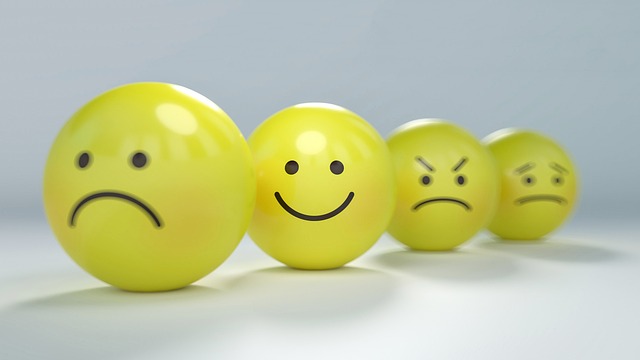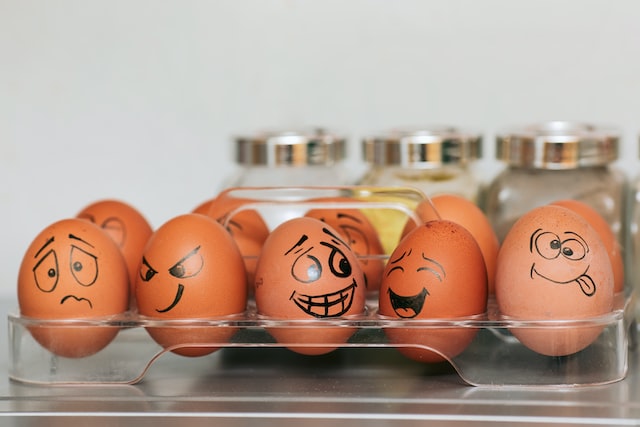Moods are more general and long-lasting than emotions. Emotions are more intense and short-lived. Moods can be positive or negative, but they don’t always have a specific cause. Emotions always have a specific cause. For example, you might have a good mood all day, even if nothing special happens. But if you’re angry, it’s because something happened to make you angry. Moods can also affect how you feel about things. If you’re in a bad mood, you might see everything in a negative light. But if you’re in a good mood, you might be more likely to see the positive side of things.
What is Emotion?
(Photo by S&B Vonlanthen on Unsplash )

Emotion is a complex psychological state that includes our physiological reactions, thoughts, and behaviors. Moods, on the other hand, are less intense and more long-lasting.
Think of emotions as being like the weather—they can be stormy and short-lived, or they can be milder and last for days. Moods are like the climate—the overall feeling that lingers in the background, no matter what the day-to-day weather is like.
What is Mood?
(Image by Gino Crescoli from Pixabay )

Moods can be positive or negative. For example, you might wake up in a good mood and feel cheerful all day. Or you might get stuck in a funk and feel down for days on end.
There are many different factors that can influence your mood. Hormones, sleep, diet, and weather can all play a role. But so can your thoughts and outlook on life. If you generally have a positive outlook, you’re more likely to experience positive moods.
Emotions vs. Moods
Emotions and moods are both related to our subjective experiences, but they have some important differences.
Emotions are intense, relatively short-lived states of feeling that are often triggered by specific events or situations. For example, you might feel happy when you receive good news, or angry when someone cuts you off in traffic. Emotions can be positive or negative, and they often involve physiological changes in the body, such as changes in heart rate, blood pressure, and facial expressions.
Moods, on the other hand, are longer-lasting states of feeling that are less intense than emotions and are not always tied to specific events or situations. Moods can persist for hours, days, or even weeks, and they can be influenced by a wide range of factors, such as weather, hormonal changes, or life events. Unlike emotions, moods are not always consciously recognized, and they may not be accompanied by specific physiological changes.
Emotions are intense, short-lived states of feeling that are often triggered by specific events or situations, while moods are longer-lasting, less intense states of feeling that are not always tied to specific events or situations.
The Different Types of Emotions
There are a variety of emotions that humans experience. Some of these emotions include happiness, sadness, anger, fear, love, and jealousy. Each emotion is associated with a different set of behaviors. For example, people who are happy may smile and laugh more often than those who are feeling other emotions.
While all emotions can be categorized into primary groups (such as happiness or sadness), there are also more specific sub-categories of emotions. For example, within the category of happiness there may be further distinctions between joy, contentment, and satisfaction. Additionally, some research has suggested that there may be universal emotions that are experienced across all cultures, such as pride or shame.
The Different Types of Moods
There are four different types of moods: positive, negative, depressive, and elated.
Positive moods include happiness, satisfaction, hopefulness, and contentment.
Negative moods include sadness, anxiety, anger, and frustration.
Depressive moods include feelings of hopelessness, worthlessness, and despair.
Elated moods include feelings of joy, excitement, ecstasy, and euphoria.
It’s important to note that Mood Disorders are different from the general day-to-day ups and downs that we all experience. Mood disorders are much more serious and can have a profound effect on a person’s ability to function in their everyday life.
How Emotions and Moods Affect Us
Emotions are intense, short-lived states that are triggered by an event or situation. Moods, on the other hand, are more long-lasting and less intense. They are often described as a general feeling or atmosphere.
While emotions can be positive or negative, moods tend to be more passive. But just because they’re not as dramatic as emotions doesn’t mean they don’t have an effect on us. In fact, research shows that moods can actually influence our decision-making.
For example, studies have shown that people in a positive mood are more likely to take risks, while those in a negative mood are more likely to play it safe. Moods can also affect how we process information. For instance, people who are feeling happy tend to see the glass half full, while those who are feeling sad tend to see it half empty.
Ways to Manage Emotions and Moods
It’s important to understand the difference between the two. Emotions are more intense and short-lived than moods. They’re also usually caused by a specific event or situation. Moods, on the other hand, are more general and long-lasting.
That said, there are a few key ways to manage both emotions and moods. One is to simply be aware of your triggers – that is, the things that tend to set off your emotions or moods. Once you know what these are, you can try to avoid them or be prepared for them when they do happen.
Another way to manage your emotions and moods is through self-care. This includes things like getting regular exercise, eating a balanced diet, getting enough sleep, and taking breaks when you need them. When you take care of yourself physically, it can help improve your emotional and mental state as well.
Finally, another way to manage your emotions and moods is through talking to someone else about them. This could be a friend, family member, therapist, or anyone else who you feel comfortable talking to. Sometimes just putting your feelings into words can help you feel better and make them more manageable.
Is love an emotion or mood?
Love is often thought of as an emotion, but it can also be considered a mood. Moods are more long-lasting than emotions and can affect our overall outlook on life. Love, specifically, is a complex emotion that can be influenced by our moods. When we are in a good mood, we may be more inclined to feel love for others. Conversely, when we are in a bad mood, we may find it harder to experience love.
What is the strongest emotion?
There is no definitive answer to this question as everyone experiences and perceives emotions differently. However, some experts believe that the strongest emotion is fear. This is because fear is often accompanied by a strong physical response, such as an adrenaline rush, which can make us feel more alert and focused. Other intense emotions, such as anger or happiness, may also produce physical reactions, but these are usually not as intense as those associated with fear.
Can emotions physically affect a persons health?
It is common knowledge that emotions can affect a person’s health. For example, stress can lead to high blood pressure and anxiety can cause headaches. However, it is not always clear how emotions physically affect a person’s health.
There are a few ways that emotions can physically affect a person’s health. One way is by affecting the immune system. Emotions like stress and anxiety can weaken the immune system, making a person more susceptible to illness. Additionally, emotions can affect the digestive system. Stress and anxiety can lead to stomachaches, nausea, and diarrhea.
Another way that emotions can physically affect a person’s health is by affecting the nervous system. Emotions like fear and anger can cause an increase in heart rate and breathing rate. Additionally, these emotions can cause sweating and shaking.
Finally, emotions can also affect hormone levels in the body. Stress and anxiety can cause an increase in cortisol levels, which can lead to weight gain and other health problems.
It is important to remember that everyone experiences emotions differently and that not all emotions will have the same physical effect on every person. However, it is clear that emotions can have a significant impact on a person’s physical health.
What are the disadvantages of being moody?
While moods are a natural and normal part of human experience, having frequent and extreme mood swings can have several disadvantages, including:
- Difficulty maintaining relationships: People with unpredictable and volatile moods may find it challenging to maintain stable relationships with others, as their moods can impact their behavior and communication style.
- Reduced productivity: Extreme mood swings can negatively impact an individual’s ability to focus, complete tasks, and stay motivated. This can result in reduced productivity and poor performance in school or work.
- Increased stress: When a person experiences frequent and extreme mood swings, they may become more stressed and anxious, which can lead to physical and mental health problems.
- Decreased quality of life: People with intense mood swings may experience a decreased quality of life due to the impact on their relationships, productivity, and overall well-being.
- Risk of developing mood disorders: Individuals who experience frequent and extreme mood swings may be at a higher risk of developing mood disorders such as depression or bipolar disorder.
Overall, while moods are a natural part of human experience, having extreme and unpredictable mood swings can have negative consequences on an individual’s relationships, productivity, well-being, and mental health.








